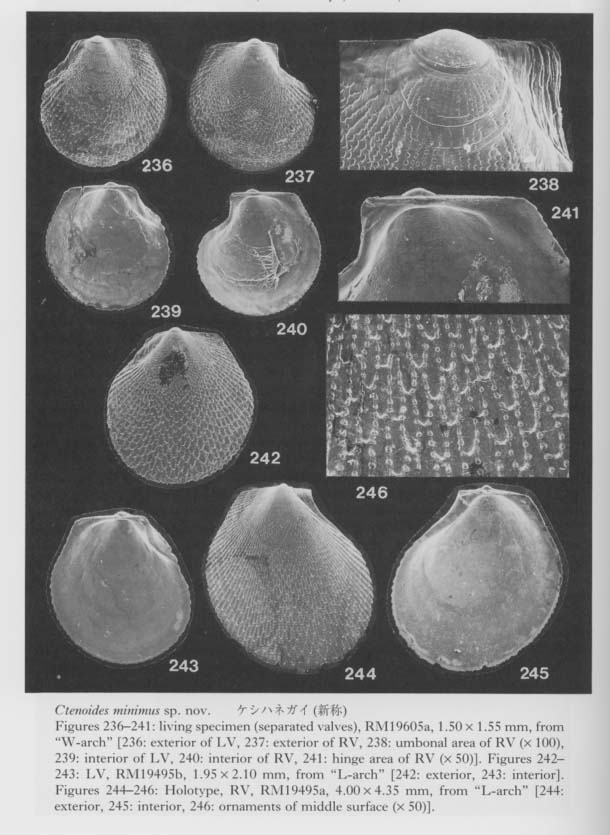Genus Ctenoides Mörch, 1853
Ctenoides minimus sp. nov.
Figures 236-246

1992. Ctenoides sp., Kase and Hayami, Jour. Moll. Studies, vol.58, p.448, listed.
Type and material.—Holotype: RM19495a, a right valve, from the bottom sediments of "L-arch" of Irabu Islet, Miyako Islands. Paratype: RM19490 (dead) from "Devil's Palace", RM19491 (dead) from "Fool's Palace", RM19492 (dead) from "Toriike", RM19493 (dead) from "Black Hole", RM19606 (dead) from "Coral Hole" of Shimoji Islet. RM19494 (dead) from "Lunch Hole", RM19605 (partly living) from "W-arch", RM19495 (dead) from the type locality, RM19496 (dead) from "Cross Hole" of Irabu Islet. RM19497 (dead) from "Shodokutsu" of Ie Islet.
Diagnosis.—Very small-sized and considerably inequivalve species of Ctenoides, characterized by opisthoclinal shell, reflected anterior auricle of LV, deeply excavated anterior margin of RV, quincuncial arrangement of punctations on early dissoconch, and numerous radial ribs with alternating scales on later dissoconch.
Description.—Shell extremely small, about 5 mm high in the largest individual, very thin, inequivalve, more or less opisthocline, subovate, not much elongated. Form ratio (height/length) 1.1-1.3, becoming larger with growth. Dorsal margin relatively long; umbo located far anteriorly from its midpoint. Anterior auricle well delimited, swollen, marked with irregular growth lamellae in LV, while its anterior margin is deeply concave in RV. Anterior umbonal ridge not developed at all. Posterior auricle not clearly demarcated but somewhat flattened. Early dissoconch marked with quincuncially disposed punctations, followed by more than 50 radial ribs with alternating scales in later dissoconch (except anterior auricle). Radial ribs not divergent, but alternating scales give an impression of diagonally oriented sculpture. Cardinal area narrow, with subvertical low-triangular ligament pit. Denticles of provinculum commonly persistent, but a rudimentary tooth observed near anterior and posterior end of hinge plate. Pd I D-shaped, large, ranging 177-203 µm in maximum diameter; Pd II absent.
Remarks.— In most caves this species is represented by empty shells, but an immature individual has been found attached pleurothetically to the surface of a rock fragment at "W-arch". The shape of anterior auricles differs remarkably between LV and RV, but a similarly asymmetric feature of this part is commonly observed in the early growth stage of the species of Ctenoides and Jurassic Ctenostreon, probably indicating pleurothetic living orientation.
The shell size of available specimens may be unusually small for Ctenoides, but every character suggests that it is a diminutive and paedomorphic species of this genus. The adult size is still difficult to estimate from the size frequency distribution, but abundant occurrence of empty valves in the cave sediments suggests that this is a cavernicolous species.
Distribution.— Common in many sublittoral caves of Shimoji, Irabu and Ie Islets, Ryukyu Islands. This species also occurs in "Balicasag Cave" off Panglao Islet of Bohol Island, the Philippines.